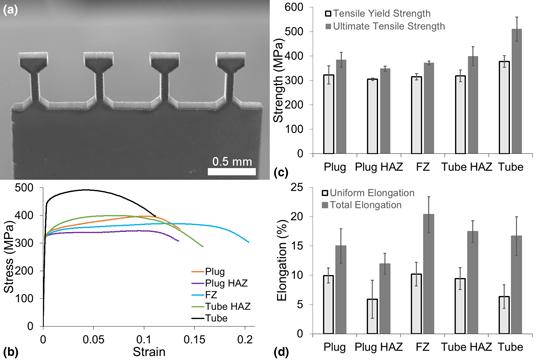Crossref Citations
This article has been cited by the following publications. This list is generated based on data provided by
Crossref.
El-Atwani, Osman
Kim, Hyosim
Gigax, Jonathan G.
Harvey, Cayla
Aytuna, Berk
Efe, Mert
and
Maloy, Stuart A.
2021.
Stable, Ductile and Strong Ultrafine HT-9 Steels via Large Strain Machining.
Nanomaterials,
Vol. 11,
Issue. 10,
p.
2538.
Harvey, Cayla
Torrez, Avery J.
Lam, Sebastian
Kim, Hyosim
Maloy, Stuart A.
and
Gigax, Jonathan G.
2021.
Demonstration of a High-Throughput Tensile Testing Technique Using Femtosecond Laser-Fabricated Tensile Bars in AISI 316 and Additively Manufactured Grade 91 Steel.
JOM,
Vol. 73,
Issue. 12,
p.
4240.
Dong, A.
Duckering, J.
Peterson, J.
Lam, S.
Routledge, D.
and
Hosemann, P.
2021.
Femtosecond Laser Machining of Micromechanical Tensile Test Specimens.
JOM,
Vol. 73,
Issue. 12,
p.
4231.
Bao, Weikang
Wang, Hao
Liu, Jizi
and
You, Zesheng
2022.
Microstructural and mechanical characterizations on Cu machined and sidewise polished by femtosecond laser.
Materials Science and Engineering: A,
Vol. 855,
Issue. ,
p.
143834.
Zhang, Yifan
Gigax, Jonathan G.
Nizolek, Thomas J.
Carpenter, John S.
Schneider, Matthew M.
Li, Nan
Capolungo, Laurent
and
McCabe, Rodney J.
2022.
Tensile and failure behaviors of Cu/Nb nanolaminates: the effects of loading direction, layer thickness, and annealing.
Acta Materialia,
Vol. 240,
Issue. ,
p.
118346.
Hong, JongDae
Ahn, Daehyeok
Jang, Dongchan
Oh, Hongryul
Kim, JaeYong
Kim, Hyochan
and
Ševeček, Martin
2023.
Measurement of local mechanical properties for Cr-coated accident tolerant fuel cladding.
Journal of Nuclear Materials,
Vol. 579,
Issue. ,
p.
154407.
Dong, A.
Vo, H.
Olivas, E.
Bickel, J.
Hardie, C.
Hosemann, P.
and
Maloy, S.
2023.
The effect of sample thickness on micro-mesoscale tensile properties of 304SS, HT-9, and CuCrZr.
Journal of Nuclear Materials,
Vol. 575,
Issue. ,
p.
154207.
Szabó, Péter Imre
Ugi, Dávid
Gilicze, Barnabás
Dankházi, Zoltán
Lipcsei, Sándor
Homik, Zsolt
and
Tóth, Zsolt
2023.
Micromachining using the high energy flat-top beam of a femtosecond pulse UV laser system: micropillar prefabrication.
Applied Physics A,
Vol. 129,
Issue. 6,
Mirmohammad, Hadi
Regmi, Abiral
Chang, Jiyoung
and
Kingstedt, Owen
2024.
Demonstration of an integrated-heating load frame for quantitatively assessing microscale tensile properties of copper and Zircaloy-2.
Journal of Nuclear Materials,
Vol. 601,
Issue. ,
p.
155339.
Sun, Tianyi
Niu, Tongjun
Shang, Zhongxia
Shen, Chao
Xie, Dongyue
Wang, Jian
Wang, Haiyan
and
Zhang, Xinghang
2024.
High‐Temperature Mechanical Behavior of Single‐Crystal FeCrAl Alloy Under In Situ Micropillar Compression.
Advanced Engineering Materials,
Vol. 26,
Issue. 21,
Niu, Tongjun
Lee, Ross
Lam, Sebastian
Hafen, Joseph
Lukow, Steven
Li, Nan
Hosemann, Peter
and
Gigax, Jonathan
2025.
A Novel Machine Learning-Driven Approach to High Throughput Mechanical Testing.
JOM,
Vol. 77,
Issue. 4,
p.
2121.
